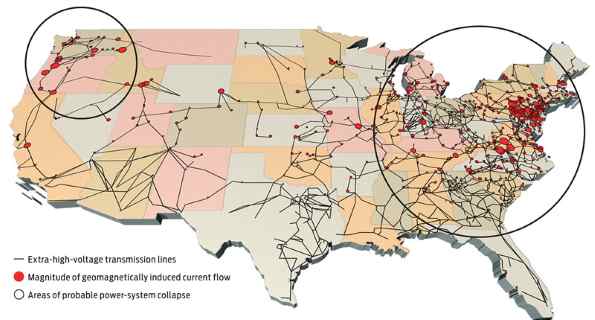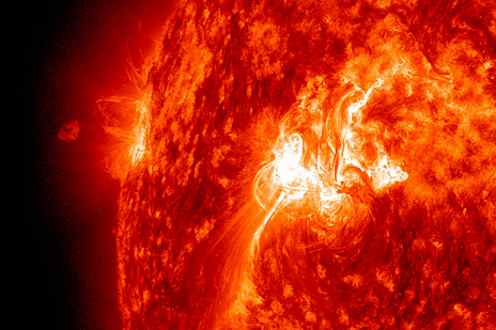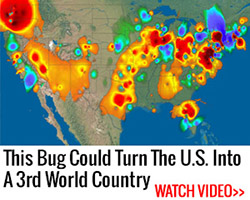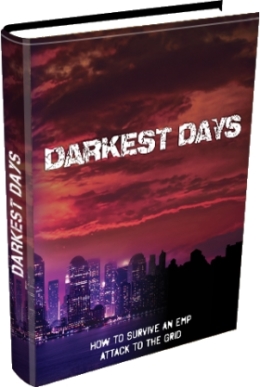Superstorm could disrupt power grids all over the world
The approach of the solar maximum is an urgent reminder that power grids everywhere are more vulnerable than ever to geomagnetic effects.
Flare Up: The sun emits an M-class (moderate level) flare, as captured by NASA’s Solar Dynamic Observatory on 25 September 2014. Solar flares and coronal mass ejections are the primary ways in which the sun can trigger geomagnetic storms here on Earth. With solar activity expected to peak in late 2014 or 2015, concerns rise that a geomagnetic superstorm could disrupt power grids all over the world.
Luminous fingers of intense red, green, and violet light flicker and pulse across the northern and southern skies like a vast cosmic conflagration. Within minutes, millions of people are tweeting, texting, and blogging about the wondrous sight. But then the sky turns a deep blood red, and fascination turns to panic.
Linked to the celestial spectacle are enormous fluctuations of the magnetic field in Earth’s magnetosphere, which are causing immense flows of electric current in the upper atmosphere over much of the planet. Those huge currents disturb Earth’s normally quiescent magnetic field, which in turn induces surges of current in electrical, telecommunications, and other networks across entire continents. Streetlights flicker out; electricity is lost. A massive planetary blackout has occurred, leaving vast swaths of North and South America, Europe, Australia, and Asia without power.
RELATED : Attack on Our Power Grid: The Existential Threat No One Is Talking About
Within a few months, the crisis has deepened. In many areas, food shortages are rampant, drinking water has become a precious commodity, and patients in need of blood transfusions, insulin, or critical prescription drugs die waiting. Normal commerce has ground to a halt, replaced by black markets and violent crime. As fatalities climb into the millions, the fabric of society starts to unravel.
Of course, no geomagnetic storm has ever wreaked such global havoc. But the last time we had a truly powerful storm was in 1921—decades before developed economies became utterly dependent on electrical infrastructure. The doomsday scenario described above is based closely on the warnings of numerous government panels and industry studies I’ve participated in during my more than 30 years of investigating the problem that extreme space weather poses to power grids. A 2008 U.S. government report prepared for the Federal Emergency Management Agency put the yearly financial impact of such an event at more than US $1 trillion. And like other reports before and since, it predicted catastrophic damage not just to electricity grids but also to oil and gas pipelines, undersea communication cables, telephone networks, and railways. Repairing that critical infrastructure would take months or even years.
Now is a good time to consider the awesome and cyclical tempestuousness of our star: Solar activity tends to occur in cycles that peak in frequency and intensity every 11 years, and the next peak is expected later this year or early the next. To be sure, not every peak—also known as a solar maximum—brings a killer storm; the last notable one occurred in March 1989. It took down Quebec’s entire grid within seconds, leaving 6 million customers without power for 9 hours. A later surge in the storm destroyed a large transformer at a New Jersey nuclear plant and nearly took down U.S. power grids from the mid-Atlantic through the Pacific Northwest.
DARK QUEBEC Animations show how the 1989 storm affected the North American grid.
But that geomagnetic storm was not so bad, it turns out. A recent forensic analysis I did of historic storms, including the planetwide event in 1921 and an even bigger one in 1859, strongly suggests that Earth has been lashed by superstorms up to 10 times as powerful as the 1989 event. The bad news is that it’s likely—certain, even—that such a storm will happen again. And when it does, it will be one of the worst disasters in recorded history.
From where we sit, the sun seems quiet enough. And yet it is constantly bombarding Earth with electrons, protons, and radio through X-ray waves. The charged particles are ejected from the star’s upper atmosphere and carried through space at a clip of 300 to 400 kilometers per second, arriving at our atmospheric doorstep about four days after leaving the sun. Under normal circumstances, this solar wind produces only negligible effects on Earth.
RELATED : How to protect the grid from solar storms
Occasionally, though, the sun erupts violently, emitting solar flares or throwing out coronal mass ejections consisting of billions of tons of charged particles. At such times, the solar wind blows considerably harder, at speeds of over 2000 km/s, organized into strong magnetic fields and with particle densities and temperatures an order of magnitude higher than normal. When it hits Earth’s upper atmosphere, the solar wind connects with and expands Earth’s magnetosphere, including the long tail-like portion that streams out from the nighttime side of the planet. This magnetotail swells and elongates until it becomes unstable and breaks in two.
The part of the magnetotail that’s no longer attached to Earth drifts off into space, while the rest snaps back violently, like a broken rubber band. In the process it forces plasma back into Earth’s upper atmosphere, where a large current of more than a million amperes—called an electrojet—builds up at an altitude of about 100 km and produces brilliant auroras. In average-size storms, this electrojet extends only over the globe’s higher latitudes, like a halo circling one of the poles. But during very large storms, such as those in 1989 and 1921, it can also reach down to the lower latitudes, where most of the world’s population and its infrastructure dwell.
That’s not the only means by which the sun can upset Earth’s geomagnetic balance. Coronal mass ejections that are big enough can collide directly with Earth’s magnetosphere, releasing enough energy to collapse it on the daytime side of the planet from more than 64 000 km to less than 25 000 km in just a minute or two. The solar wind can buffet the magnetosphere, creating giant electromagnetic waves, much as hurricane winds kick up surf on the ocean. At lower latitudes, space weather can set off geomagnetic activity of a lesser intensity but longer duration, which can be as damaging to electric grids near the equator as other types of storms can be at higher latitudes.
But how does all this space weather cause damage down on the ground? It’s a multistep process. First, the intense magnetic field variations in the magnetosphere induce electric fields and currents over large areas of Earth’s surface. In turn, this geoelectric field creates what are known as geomagnetically induced currents, or GICs, which flow in any available conductor, including high-voltage transmission lines, oil and gas pipelines, railways, and undersea communications cables. These interconnecting networks essentially act as giant antennas that channel the induced currents from the ground. Hit with a 300-ampere GIC, a high-voltage transformer’s paper tape insulation will burn, its copper winding will melt, and the transformer will fail, either right then and there or in the future.

Source: Peter Warner/Storm Analysis Consultants; Map: John MacNeill
Lights Out: A simulation of an extreme geomagnetic storm at 50 degrees geomagnetic latitude shows a widespread collapse of the power grid in the eastern and northwest portions of the United States, which together have a population of more than 130 million people. The black lines indicate extra-high-voltage transmission lines and major substations. The red dots indicate the locations and magnitude of the geomagnetically induced currents that would flow across the network. In this scenario, more than 300 large EHV transformers would either fail or suffer permanent damage.
High-voltage power grids are designed to withstand the loss of any single important element, such as a substation transformer, and then recover within a half hour or so. For a terrestrial storm like a hurricane or a tornado, this approach works well. But a severe geomagnetic storm covering an entire continent would cause multiple failures all at once. During the first 30 seconds of the 1989 storm, the Quebec grid experienced 15 simultaneous failures—and the unsurprising result was a province-wide blackout. And that storm, remember, was far from the worst Earth has seen.
It took scientists a while to make the connection between something happening on the sun and something happening on Earth. Given the separation between the two events of hours or days and 150 million km, maybe that’s not too surprising. The first person to begin connecting the dots was a British amateur astronomer named Richard Carrington, who while doing daily sunspot observations saw a huge “white light” flare on the sun on 1 September 1859. This flare was both preceded and followed by incredible bloodred auroral displays that engulfed the planet from the poles to the tropics.
In that era, the only widespread electrotechnology was the telegraph. Electrical current surged through telegraph lines and blew out the batteries that supplied power to them. Telegraph operators were stunned by arcs of electricity leaping from their equipment. Other enterprising operators disconnected the batteries, reconnected the telegraph armature directly to ground, and were able to continue working with just the “celestial” current flowing through their lines.
Over the next few decades, others would expand on the connection between solar activity and geomagnetic storms. But skeptics were also plentiful, including the great physicist Lord Kelvin, who until his death in 1907 remained convinced that Maxwell’s equations ruled out any kind of direct influence the sun might have on Earth.
The debate went unresolved until 1959, when the Soviets’ Luna 1 satellite finally confirmed the existence of the solar wind. Carrington was long dead by then, of course, but the 1859 storm, one of the most severe in recorded history, is now known as the Carrington event [see “Important Dates in Solar History”].
Could another hemisphere-walloping event occur during the approaching solar max? There’s really no telling. The fact is, geomagnetic storms can occur at any point in the solar cycle, and not all solar flares or coronal mass ejections will trigger a storm. Most of them, after all, will be pointed away from Earth. Of the earthbound ones, the damage they do depends on, among other things, the polarity of the magnetic field carried by the solar wind. If the polarity is the same as that of Earth’s magnetic field, most of the particles will be deflected harmlessly into space. Eventually, though, we will get a Carrington-class flare that will trigger a superstorm the likes of which we have never seen. For that we are woefully unprepared.
The 1989 geomagnetic storm that blacked out Quebec led to many sobering studies and some potentially promising research, but not much actually changed. No regulations were added to require utility companies to harden their infrastructures, monitor for geomagnetically induced currents, or report transformer failures following geomagnetic storms—and so for the most part, the utilities haven’t. There is still no design code for the grid and its components that takes into account threats from space weather.
Meanwhile, the world has become more electrified. In the United States, the extra-high-voltage (EHV) portion of the power grid has grown by a factor of 10 since the late 1950s. China’s grid is even more vulnerable, because portions of it now operate at even higher voltages—1000 kilovolts versus a maximum of 765 kV in the United States. Higher voltages can force higher GICs to flow into the grid, because the resistance of high-voltage lines is lower per unit length than it is for lower-voltage lines. But China is just following a worldwide trend: In general, utilities are pushing voltages higher to reduce the amount of energy lost over long distances. But they do so without considering the heightened risk.
Of all the parts of the power grid, high-voltage transformers are among the most likely to fail in a geomagnetic storm and also among the most difficult to replace. If a big storm were to knock out several hundred transformers in one fell swoop, manufacturers wouldn’t be able to supply replacements quickly—there is no global stockpile. EHV transformers, which can handle voltages of 345 kV or higher, weigh about 200 tons and cost about $10 million each. Building one requires exquisite, near-artisanal craftsmanship, including meticulously hand winding the paper-tape insulation around the copper winding at the transformer’s core. One EHV transformer can take several weeks to assemble and test, and it takes years to train skilled assemblers. Even the largest transformer plants can build only about 30 to 50 per year. With the shortage of skilled labor and specialized materials that would likely accompany a prolonged blackout, simply maintaining that level of output would be a challenge, never mind ramping up new production.
There is a quick and relatively cheap fix to help protect these transformers from geomagnetically induced currents: They can be retrofitted to block the inflow of GICs. But no utilities anywhere routinely protect their multimillion-dollar transformers in this way. Also worrisome is that many transformers in the United States, Western Europe, and Japan are fast approaching the end of their useful lives. The average age of U.S. transformers is about 40 years. Over the decades, each of these devices has likely experienced at least minor overheating and other insults from GICs. An aged transformer that’s been exposed to repeated injury is of course far more likely to fail than a brand-new transformer.
Unfortunately for grid operators and others who have to deal with the consequences of geomagnetic disturbances, existing tools for assessing severe space weather fall short. The space-based Solar and Heliospheric Observatory now offers gorgeous images of solar flares as they burst forth from the sun’s surface, while the Advanced Composition Explorer satellite makes very precise measurements of the solar wind. As a result, computer models of space weather can now accurately predict when the solar wind will reach Earth. But space weather experts still don’t know which kinds of solar activity will likely cause real damage.
The traditional way of gauging solar storm intensity is the G-scale, which rates storms from 1, the least severe, to a maximum of 5. It’s based on an 80-year-old metric known as the K-index, which reflects the change in Earth’s magnetic field over a 3-hour period. For instance, the most severe storm has a K-index of 9 (which corresponds to a G-scale rating of 5), meaning the magnetic field variation exceeds 500 nanoteslas during the 3 hours. That’s relatively small compared to Earth’s average magnetic field of about 60 000 nT.
But for the power grid, the K-scale’s 3-hour time scale is useless because the magnetic spikes of greatest concern happen over just a few seconds or minutes; the higher the rate of change, the greater the impact. Experts use the shorthand “dB/dt” to refer to this rate of change. But whether the change happens over 30 seconds or 3 hours, it would register the same value on the K-index. And while the index tops out at 500 nT, actual storms can go much higher. The 1989 storm, for example, had fluctuations of 400 to 500 nT per minute over North America, so according to the K-index, it was among the worst. However, my analysis of data from the 1921 storm indicates it reached an intensity of 5000 nT per minute—10 times as great as the 1989 event.
Of the several K-9 storms that have come after the March 1989 storm, all had lower dB/dts and as a consequence were far less destructive. However, this may have created a sense of complacency within the electric power industry that it has done enough post-1989 to prepare for the “worst” storms.
Fortunately, protecting against the space-weather threat should be neither expensive nor difficult. Almost all modern power grids use a three-phase design, in which each of three lines carries an alternating current whose phase is separated from the other two by a third of a cycle.
The three-phase transformers used in this scheme are directly grounded through their neutrals. The ground is assumed to be an infinite sink that can absorb any brief, large fault current and at the same time keep the voltage across the grid from spiking and damaging equipment. In retrospect, that design is flawed: During a geomagnetic storm, the sink becomes a source of GICs, flowing into the grid from the ground.
Preventing the inflow of GICs into the grid through the neutral-to-ground connection is the best long-term solution. One idea is to install capacitors at the neutral-to-ground juncture, which would block the inflow of GICs or any other direct current but otherwise allow the continuous flow of small AC currents that are common from the neutral to the ground. The challenge is devising a way to automatically bypass the capacitor in the event of an actual fault and allow a large AC current—say, more than 20 kiloamperes—to flow to ground from the neutral. Such gear was developed under a research program I directed for the Electric Power Research Institute in the early 1990s. But the switching devices of that era were too slow, expensive, and complex, and they couldn’t handle high currents.
Recently, though, an old technology has been revived that appears to have all of the right qualities: the trusty vacuum tube. A start-up called Advanced Fusion Systems, based in New Rochelle, N.Y., has developed a capacitor bypass device that uses a high-power vacuum tube that it says can bypass the capacitor within a fraction of an alternating current cycle, far speedier than any existing mechanical switch, power transistor, or spark gap could.
The design is still being vetted, but if it proves successful, retrofitting the neutral-to-ground connections with these bypass devices would be far less costly than having to replace tens or hundreds of the transformers themselves following a major geomagnetic storm.
So here you are at the end of the article. If you never gave much thought to geomagnetic storms before (and let’s face it, you never did), I hope you now appreciate the extraordinary risk that extreme space weather poses to our critical systems and even our way of life.
Our infrastructure has greatly expanded and grown more complex—and also more vulnerable. We engineers have presided over this growth and can feel justifiably proud of what it has brought society. But we have also unintentionally created a disaster in the making, and it is time we addressed it. As an engineering community, we should realize there are no reprieves from the laws of physics. If we do nothing—if we stand by and wait for politicians to appreciate the risks and act on them—we may witness one of the worst catastrophes of all time.
Survival MD (Best Post Collapse First Aid Survival Guide Ever)
Backyard Innovator (A Self Sustaining Source Of Fresh Meat,Vegetables And Clean Drinking Water)
Blackout USA (EMP survival and preparedness)
Conquering the coming collapse (Financial advice and preparedness )
Liberty Generator (Build and make your own energy source)
Backyard Liberty (Easy and cheap DIY Aquaponic system to grow your organic and living food bank)
Bullet Proof Home (A Prepper’s Guide in Safeguarding a Home )
Family Self Defense (Best Self Defense Strategies For You And Your Family)
Sold Out After Crisis (Best 37 Items To Hoard For A Long Term Crisis)
About the Author
John Kappenman is a leading expert on the disastrous consequences a severe geomagnetic storm could have on the electrical infrastructure. “My first assignment as a power engineer was to devise solutions for all the problems these storms pose to power grids,” he says. He failed to do that in the allotted 6 months but stuck with it for more than 30 years. He frequently testifies before Congress and advises U.S. government panels on the topic.





